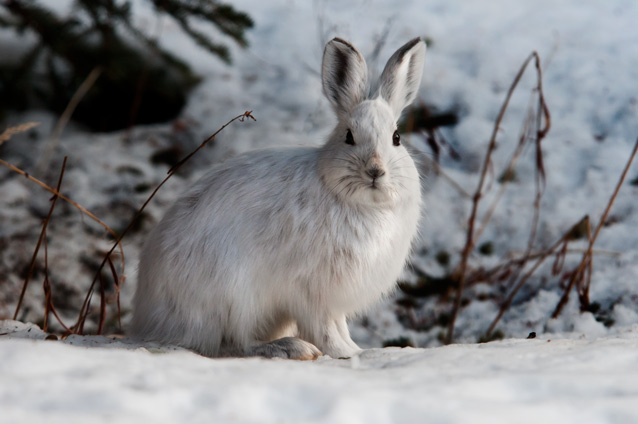
Editor’s note: This article is the second in a two-part series focused on forests and climate change. The first article discussed how forests interact with carbon – primarily as sources and sinks for atmospheric carbon. This article discusses just a few of the myriad ways that forest ecosystems – trees, wildlife and the ecosystem services that forests regulate – are impacted by climate change.
Scott Mills reaches across the table and grabs a salt shaker in one hand and a pepper shaker in the other. The salt represents a snowshoe hare in its winter coat, the pepper that same hare in its summer coat. He moves the shakers around the table, a bit of drama to underscore his point.
Mills, a wildlife biology professor at the University of Montana has studied snowshoe hares and climate change for the past two decades and finds the intersection of if and how animals can adapt to our changing climate “totally fascinating.”
Mills is talking about how climate change impacts forested ecosystems. Snowshoe hares and other seasonally camouflaged animals are perfect examples of just how these effects manifest in nature.
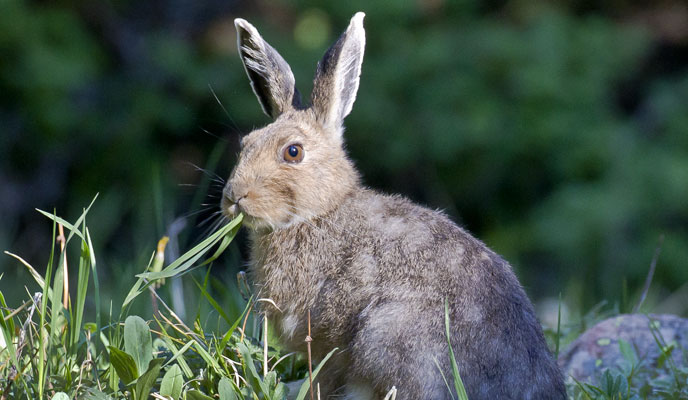
“When you’re talking about to what extent climate change affects wildlife populations, snowshoe hares are a good example,” Mills says. “You’re looking at what does reduced snowpack mean for snowshoe hare.”
Snowshoe hare, like 21 other species around the world, change their coat when winter arrives, turning from brown to white. Evolutionarily adapted to change back to brown when the snow melts, the snowshoe hare is basically a living example of what happens when the Earth changes faster than a species can adapt.
This hare has long been studied in forested ecosystems, mostly because it is the main prey of Canada lynx, a snow-adapted feline that dines on snowshoe hare for nearly 90 percent of its diet.
The lynx is an endangered species, so researchers have studied how its main food source reacts to different forest management strategies.
Snowshoe hare are dependent on how much cover is available for hiding, so forest managers wanted to know how much vegetation was required for bountiful hare populations and, therefore, healthier lynx populations.
Without adequate forest cover, there are fewer hare. Without hare, there are fewer lynx.

What Mills and his team of researchers have studied more recently is the relationship between snowshoe hare and snow on the ground.
Snow is a function of weather, and climate change is obviously changing weather patterns. In the West, where Mills conducts most of his research, these changes imperil hares that are slowest to change their phase from white to brown.
And across the West, winter is getting shorter.
**
About two weeks shorter, according to Steve Running, a just-retired ecology professor and researcher from the University of Montana, who also was the lead author of a chapter in the IPCC’s 2007 and 2014 report on global climate change.
Running is one of the nation’s leading researchers on climate change and knows well what is happening (and what’s predicted to happen) in the western U.S. in the decades ahead.
He rattled off several effects of the warming climate that impact forests and forested ecosystems.
In the fall and spring, precipitation that once fell as snow now falls as rain; snowpack depth is at least 20 percent lower than it was 60 years ago.
Peak runoff comes two or more weeks earlier on average; March temperatures across Montana are, on average, about five degrees warmer than in the 1950s.
If you’re a human being, those are alarming statistics. If you’re a snowshoe hare that changes from white to brown later than your neighbors, those statistics are deadly.
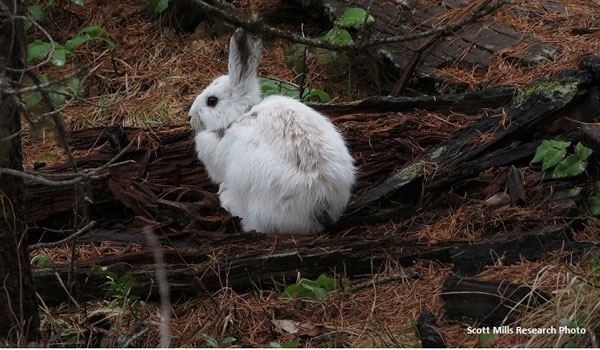
Mills and his team have documented that snowshoe hares with mismatched coats have a 7 percent higher chance of becoming a meal than hares whose coats match their environs.
Because these hares change their coat color at somewhat different times of the season (some change a bit later than others, especially in the spring), those that change back to brown later in the year are especially impacted by reduced snowpack and earlier snowmelt.
In fact, according to Mills, we might just be seeing evolution in action with snowshoe hare and coat color phenology. That’s good news for hares that change to brown earlier, bad news for those that don’t.
Snowshoe hare clearly demonstrate how forest-dwelling wildlife are impacted by climate change. But there are other ready examples as well.
Residents who live and hike in bear country now carry their bear spray starting in February and March because bears are waking from hibernation sooner due to warmer, drier springs.
Wolverines, elusive and ferocious members of the weasel family, require deep snow for denning. As climate change reduces snowpack depth in already fragmented landscapes like the Northern Rockies, these far-ranging animals struggle to find suitable denning sites, which will reduce overall populations and species viability.
**
So what can researchers and forest managers do to help wildlife populations that depend on forests to survive climate change?
Despite his research suggesting that snowshoe hare may be evolving, Mills is loathe to point to “evolutionary rescue” as a solution.
“It’s all wrapped up in how animals can adapt to such rapid changes,” he notes. “Can evolutionary rescue help? Yes. But I’m absolutely not saying we shouldn’t worry about climate change and let nature figure it out. The message comes back to old-school conservation. To foster evolutionary rescue for species, we need to nurture populations that are large, connected and dealing with one stressor at a time. In the case of hares, if natural selection is only operating on coat camouflage, then it could work.”
That’s good news for hare (at least some of them), but what about the hundreds of other species that rely on forested ecosystems? How do we maintain large enough populations, ensure they’re connected and reduce the number of stressors they face all while dealing with a rapidly changing climate? What about the forests themselves? Aren’t they just as susceptible to these changes as the animals that live in them?
**
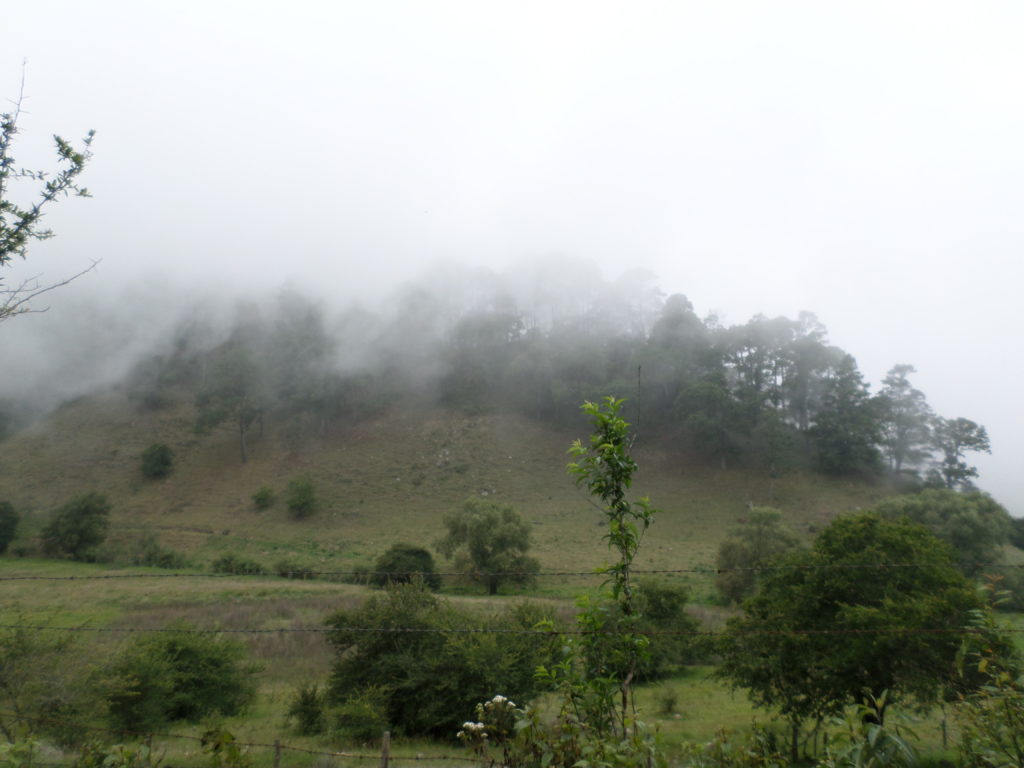
Forests cover about 31 percent of the Earth’s land. In addition to being biodiverse, they play an outsized role in regulating a number of ecosystem services. Forests provide wildlife habitat. Forests also filter water and regulate streamflows, which impacts agriculture, fisheries and recreation. Forests provide natural resources that include everything from lumber to food. Forests play a critical role in regulating global climate budgets. And forests offer some of the best and most popular recreational opportunities available. When forests themselves are impacted by climate change, a cascade of effects hurtles toward an uncertain future.
You don’t need to look any farther than your fridge to find one of these cascading effects. In the Northeast, climate change is affecting maple syrup production.
Sugar maple trees, the type that produce the sap that becomes maple syrup, are relatively sensitive to temperature. As soon as it’s above freezing in the spring, sugar maples begin producing sap. This sugar-rich fuel drives tree growth, bud growth and helps protect the tree from disease and drought and sweetens our pancakes.
But the processes that drive sap production work best within a specific and narrow temperature band. Hot springs, summers or falls can push these processes out of balance and affect how much sap a tree produces and, more importantly for maple syrup producers, how much sugar is in that sap.
In the Northeast, temperatures are up 2.8 degrees since 1971, on average, and are predicted to increase at a faster rate than in the rest of the country.
That could spell doom for the U.S.-based maple syrup industry. In Vermont alone, a 2015 study valued the economic contribution of maple syrup production at more than $300 million. While syrup producers have dealt with the changes so far, ever-warming temperatures may render their efforts useless in just a few decades
**
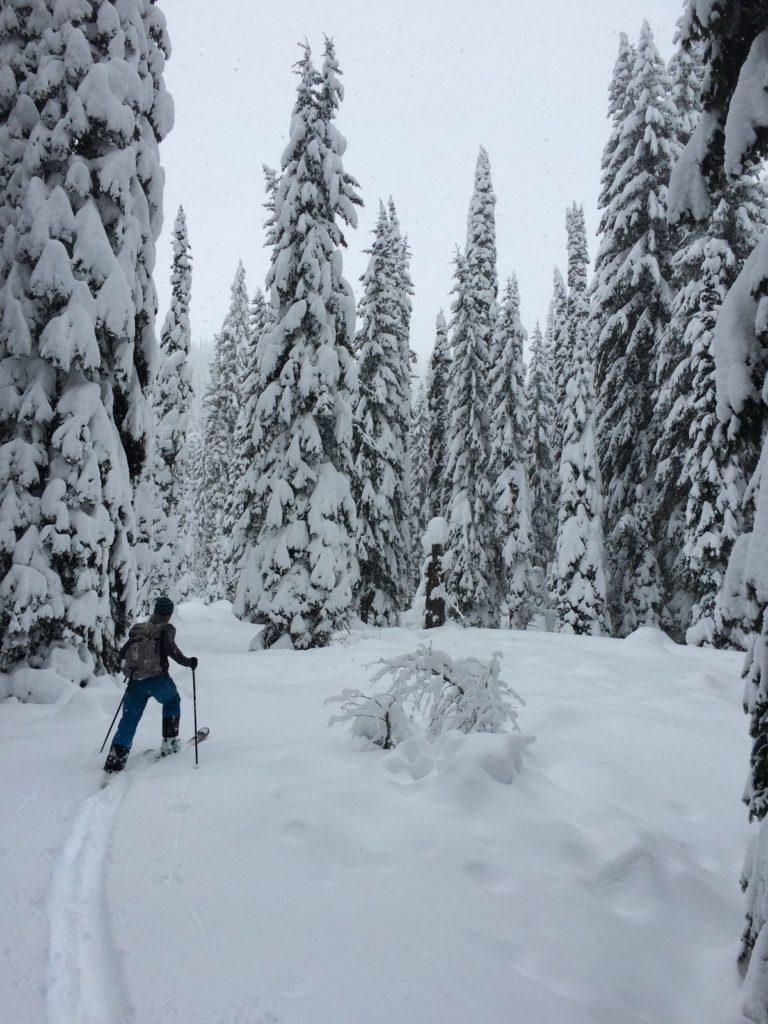
The impact of climate change on maple syrup production is tangible. So is reduced snowpack at ski resorts, something the ski industry is grappling nationwide. It’s hard to sell enough ski tickets when winter is weeks shorter.
But forest ecosystems and the regulatory controls they have on ecosystem services are complicated, making it more difficult to understand the cascading effects of climate change.
Already, there is no escaping the effects of climate change on all our lives. Here’s a personal example:
In August of 2016, I called a fly-fishing shop in Livingston, Montana, to book a shuttle for a weekend float on Montana’s famous Yellowstone River. The voice on the line informed me that the river was closed.
Confused, I asked if it was just closed to fishing. No, came the response. Two hundred miles of the Yellowstone River, the Lower 48’s longest undammed river with its headwaters in Wyoming’s wild Absaroka Mountains, was closed to all recreational use. No fishing, no floating, no tubing, no swimming.
A microscopic parasite, bolstered by low flows and warm water, had infected thousands of whitefish, which were washing up on the riverbanks dead. Managers were afraid it would spread to trout and, even worse, to other rivers and streams.
The Yellowstone, like many of Montana’s famous fisheries that summer, was running at record low flows. And, according to the Montana Fish Wildlife and Parks website I visited after learning of the closure, parts of the Yellowstone were running 15 degrees warmer than temperatures should be for healthy trout and whitefish populations.
**
For millennia, the Western water cycle was predictable. Winter snow accumulates in low-, mid- and high-elevation forests. Cold winter weather maintains that snowpack until late April or May when it starts to melt and flow through tributaries to rivers like the Yellowstone. By late summer, most of the snow is gone and the rivers run low. This process still takes place, but climate change has altered it in significant ways.
“Winter is about two weeks shorter and summer about two weeks longer. That means forests have two weeks less to accumulate water [in the form of winter snow], and that it’s needed for two weeks longer,” said Running, who was among the climate change scientists awarded the Nobel Prize for their work on the IPCC report.
This shift, he says, is the “foundation of all other effects” that are occurring in Western forests, and cascading down to rivers and valleys.
This new paradigm doesn’t just affect natural systems. Losing nearly a month of the peak summer fishing season devastates outfitters and guides, as happened on the Yellowstone in 2016.
Junior water rights holders may not get the water they need to support their farms and ranches because there’s just not enough in the streams come August and September.
Municipalities that rely on this water to slake the thirst of their residents may find themselves importing water for homes and businesses, because there isn’t enough surface water or ground water to replenish aquifers.
Many of these effects create negative feedback loops: In August, when water withdrawals by agricultural users are at their peak, there is even less water in the streams and rivers for fish, waterfowl and recreationists.
Less low-elevation snow requires ski resorts to make artificial snow, which they do by withdrawing water from natural systems. Less surface water for ranches and farms equates to more wells, reducing groundwater supplies and depleting aquifers.
It’s hard to complain about a canceled weekend float when there are so many other serious impacts being felt by human and natural communities. Especially when you consider what else Running says: “Our forests are under near perennial stress because we’ve tilted water availability. Once there is a disturbance trigger, it can have a larger impact.”
While the direct impacts of climate change – less snow, earlier melting, and warmer springs and summers – can be articulated for snowshoe hare predation, sugar maple production or late season water temperatures, it’s harder to directly connect climate change to these “disturbance triggers.” In these instances, climate change is exacerbating the impacts that these disturbances are causing, which are then causing yet more effects.
**
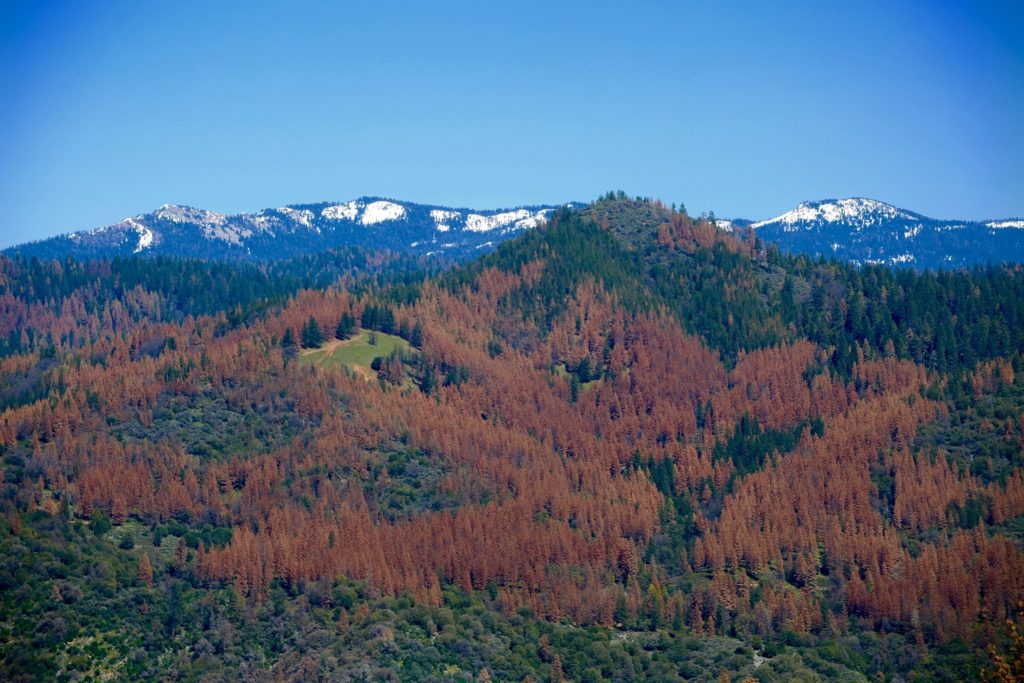
Drought has always been present on the landscape.
Archaeologists credit an extended drought as a catalyst for the disappearance of the Southwest’s ancient Pueblo peoples as far back as 1300 AD. America’s Dustbowl was caused, in part, by drought.
More recently, from 2011 to 2016, California suffered five years of severe drought conditions. The news was awash in stories about water conservation measures, neighborhood watering patrols and other efforts to conserve this precious resource. Lawn watering wasn’t the only thing affected by the drought, though – the state’s forests have seen unprecedented tree mortality.
According to the U.S. Forest Service, more than 100 million trees died in California in recent years. Yes, drought commonly kills trees, but not in the numbers seen in California. Stressed by warming temperatures and reduced water availability, California’s trees simply couldn’t withstand the additional stress of a five-year drought.
The Rocky Mountains have seen their own large scale tree die-off, only it wasn’t caused by drought. Already stressed by reduced water availability, these forests were ravaged by a tiny insect that has long been present in the ecosystem: the mountain pine beetle.
Running uses the analogy of an athlete to explain why something like drought or pine beetles can, somewhat suddenly, devastate so many trees: “These forests are like a dehydrated athlete. They don’t die immediately, they keep plugging along, but they’re diminished.”
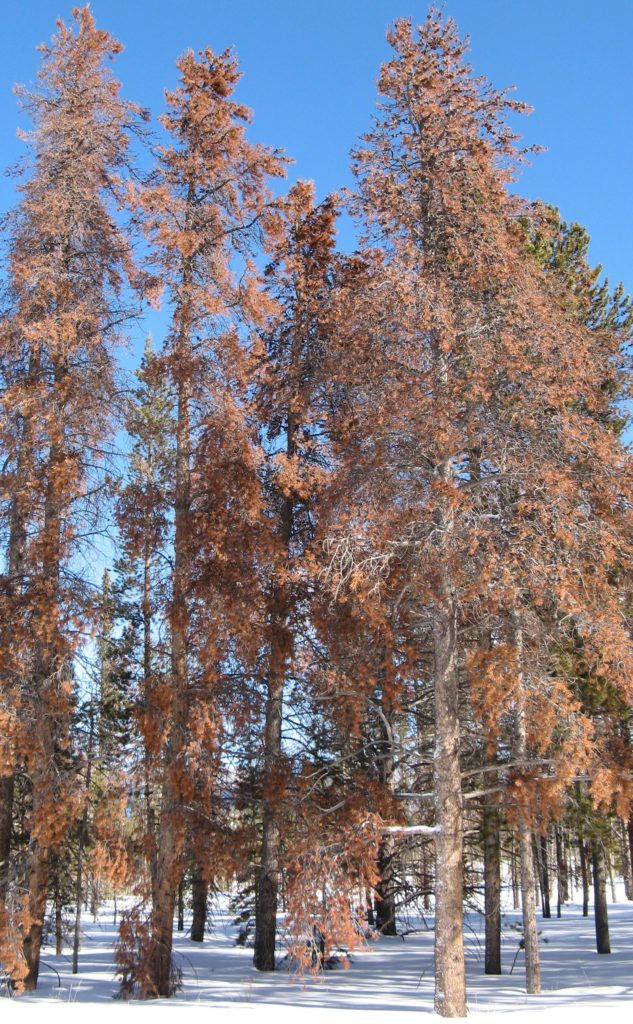
This “diminished performance” makes them more susceptible to pests like pine beetles and less able to withstand a beetle attack. They’re not going to win as many, or any, races.
The analogy works well, but trees have yet another stressor: historic management practices, particularly the exclusion of wildfire from many of the nation’s forested landscapes.
Almost all forests in the U.S. evolved with fire, many with frequent low- or mixed-intensity fires (as did the prairies of the Great Plains). These fires cleared out small-diameter trees, recycled nutrients, reduced fuel loads across the forest floor, and helped promote species and age diversity.
But beginning in the early 1900s, the nation decided to extinguish all forest fires as quickly as possible, a noble effort intended to avoid catastrophic losses of life and forest resources.
As the decades passed, many forests became densely stocked with small trees of the same species, each competing for the same limited resources. These “over-stocked” and homogeneous forests were less healthy and more susceptible to whatever disturbance trigger nature threw their way: drought, beetles, fire. Climate change.
Running has documented another climate change issue that aids pine beetle infestations and harms forests. Instances of extreme cold during the winter are less regular and less prolonged than in the past. And extended periods of sub-zero temperatures once killed many of the beetles each season, keeping population numbers in check.
Now, without those extended cold snaps, beetles not only survive the winter, they’re able to reproduce more effectively. Add this population surge to the stressed forests and the impacts appear as giant swaths of red-needled forests.
In the East, warming winters are having a similar effect on the Eastern larch beetle.
And, of course, the impacts aren’t just limited to trees. Ominously, they can extend to humans.
Across the Northeast, the incidence of Lyme disease has more than doubled in the last two decades. [possible graph from epa site]. According to the U.S. Environmental Protection Agency, the ticks that carry Lyme disease are sensitive to temperature changes and can’t survive long, cold winters en masse. As warming temperatures increase the range and prevalence of ticks across the Northeast, rates of Lyme disease increase as well.
**

One of the most severe “disturbance triggers” that forests experience is fire. Western fires have long been a part of the landscape, but they are increasing in size, severity and extent.
The Forest Service estimates that the fire season is now, on average, 78 days longer than in 1970. Westerners are faced with, and fighting back against, extreme wildfires. Still, thousands of homes burn each year, despite the best efforts of ever-increasing numbers of wildland firefighters and aerial firefighting resources.
In the East, where communities have limited wildfire experience and limited wildland-firefighting infrastructure, the consequences are perhaps even more dire.
In late November 2016, an arson-caused fire began to spread across the Great Smoky Mountains near Gatlinburg, Tennessee. In a matter of days, the fire scorched more than 17,000 acres, damaged or destroyed more than 2,400 homes and businesses, and tragically killed 14 people. The Chimney Tops 2 fire, as it became known, proved one of the most damaging fires in Tennessee’s history.
While less frequent than in drier Western forests, wildfires have long played a role in Eastern forests, clearing out smaller trees and vegetation, reducing fuel loads and recycling nutrients. As settlers moved into the Appalachians, fire exclusion became more common, culminating in the early 20th century policy that snuffed out nearly all fires all the time.
More recently, the National Park Service has implemented some prescribed fire efforts to reintroduce this natural and beneficial disturbance back on the landscape. In fact, according to the Park Service: “Occasional fires were an integral part of most Appalachian ecosystems and native plants and animals had adapted to their occurrence. … Many pine-oak and oak forests in the park appear to have very poor reproductive success without occasional fire. Little or no oak regeneration has occurred at some sites since total fire suppression was initiated in the 1930s.
Fire exclusion wasn’t the main driver of the Chimney Tops 2 fire. Tennessee and the Southeast generally had been gripped by “exceptional drought” for months. That drought dried the already dense vegetation and created the perfect storm.
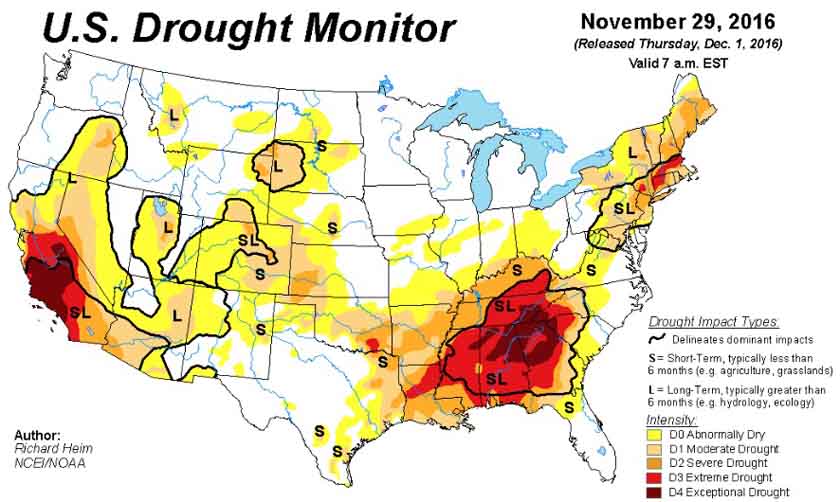
It’s hard to pin a relatively short-term drought on climate change, but models are predicting there will be more extremely dry and wet summers – the extremes of weather. And it’s the extremely dry summers, like 2016, that carry devastating effects.
Just what happens to the nation’s forests after these fires is a tricky question. Prompt replanting helps protect watersheds, improves wildlife habitat and sequesters carbon. But should they be replanted with the same species? Or should they be planted with some species from the pre-fire landscape and some that will more likely dominate these areas in 50 to 100 years – post-climate change? Or should humans stay out of the way and let the forests regenerate naturally? Forest managers and wildlife biologists across the country wrestle with these questions every day.
At the University of Montana, Mills is willing to make a stark prediction about what will happen to wildlife under climate change.
Each fall, he tells his undergraduate classes the same thing: “I am 100 percent certain that under climate change animals will do one of three things: they will move, they will adapt or they will die.”
Mills specifically references animals, but trees and other plants have the same three options. “Timberline is going up,” says Running, and trees are colonizing new areas at higher elevation.
Recent studies have documented deciduous trees moving west and coniferous trees moving north across much of the eastern U.S. Those are natural movements, where some trees have moved quickly enough to keep pace with climate’s change.
Humans can help trees move through “assisted migration,” planting species that will be well suited for the climate and weather that models predict 50 or 100 years in the future.
Mills’ own work suggests that animals can adapt through evolutionary changes, but only if conditions allow. Evolutionary adaptations, he says, require three conditions: the population must be large enough, individual populations must be connected to one another, and the species must be exposed to just one stressor at a time. Absent one or more of those conditions, animals will struggle to adapt at a pace that keeps up with the climate.
So how do humans foster that adaptation and prevent extinction? According to Mills, the key is to “reduce the number of stressors.”
That simple-sounding action echoes what Forest Service researcher Constance Millar says about managing forests in climate change.
Millar advocates three main strategies to help forests adapt: First, land managers must do what they can to help forests survive the most immediate effects of climate change by creating “resistance options,” which “forestall impacts and protect highly valued resources.”
Next, managers must create “resilience options,” which “improve the capacity of ecosystems to return to desired conditions after disturbance.”
And finally, humans must accept that the future looks different from the past and implement “response options,” which “facilitate transition of ecosystems from current to new conditions.”
In the complicated relationship between forests, water, wildlife and climate, one thing is clear: The rapid rate of change combined with the number of conditions that are changing has created impacts that are cascading across landscapes. How we deal with these changes is at the crux of how we manage forests, water and the wildlife that depend on them.
Greg M. Peters writes from Missoula, Montana, where he received a master’s of science degree in environmental studies at the University of Montana. He is a communications professional for a conservation nonprofit.
Leave a Reply